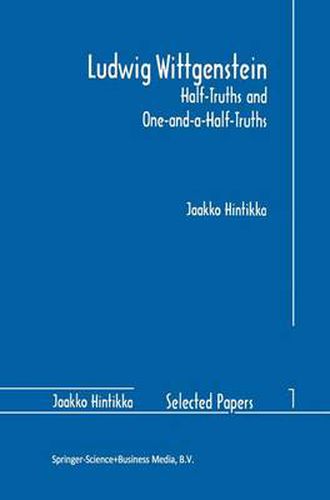Readings Newsletter
Become a Readings Member to make your shopping experience even easier.
Sign in or sign up for free!
You’re not far away from qualifying for FREE standard shipping within Australia
You’ve qualified for FREE standard shipping within Australia
The cart is loading…






This title is printed to order. This book may have been self-published. If so, we cannot guarantee the quality of the content. In the main most books will have gone through the editing process however some may not. We therefore suggest that you be aware of this before ordering this book. If in doubt check either the author or publisher’s details as we are unable to accept any returns unless they are faulty. Please contact us if you have any questions.
Frequently, a genuine understanding of a thinker’s ideas is possible only by following them further than he did himself. Wittgenstein’s Viennese contemporary Karl Kraus spoke in a similar context of one-and-a-half truths in contradistinction to half-truths. In this volume of essays, Jaakko Hintikka examines the two grand visions concerning the interrelations of language, self and the world that guided Wittgenstein’s thought at the different stages of his philosophical development. He seeks to show how one of them, the so-called picture theory of language, was in reality a combination of several independent assumptions, while the other, the idea of language-games as the vehicles of meaning, was the end product of an intriguing development. Hintikka asserts that many of Wittgenstein’s best-known ideas can, and must, be understood as defences or rationalizations of his overall visions. In several essays, Wittgenstein’s ideas are illuminated through comparisons with other philosophers, including Russell, Husserl and Carnap.
$9.00 standard shipping within Australia
FREE standard shipping within Australia for orders over $100.00
Express & International shipping calculated at checkout
This title is printed to order. This book may have been self-published. If so, we cannot guarantee the quality of the content. In the main most books will have gone through the editing process however some may not. We therefore suggest that you be aware of this before ordering this book. If in doubt check either the author or publisher’s details as we are unable to accept any returns unless they are faulty. Please contact us if you have any questions.
Frequently, a genuine understanding of a thinker’s ideas is possible only by following them further than he did himself. Wittgenstein’s Viennese contemporary Karl Kraus spoke in a similar context of one-and-a-half truths in contradistinction to half-truths. In this volume of essays, Jaakko Hintikka examines the two grand visions concerning the interrelations of language, self and the world that guided Wittgenstein’s thought at the different stages of his philosophical development. He seeks to show how one of them, the so-called picture theory of language, was in reality a combination of several independent assumptions, while the other, the idea of language-games as the vehicles of meaning, was the end product of an intriguing development. Hintikka asserts that many of Wittgenstein’s best-known ideas can, and must, be understood as defences or rationalizations of his overall visions. In several essays, Wittgenstein’s ideas are illuminated through comparisons with other philosophers, including Russell, Husserl and Carnap.